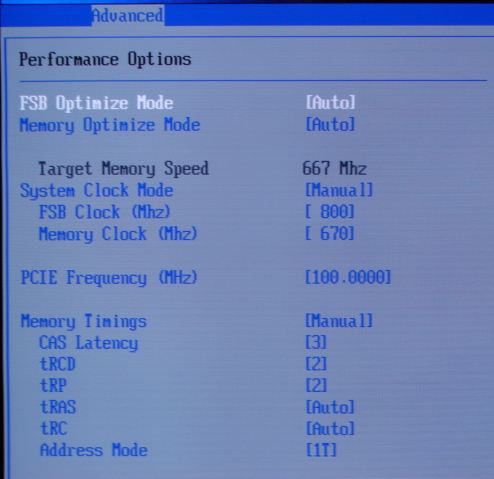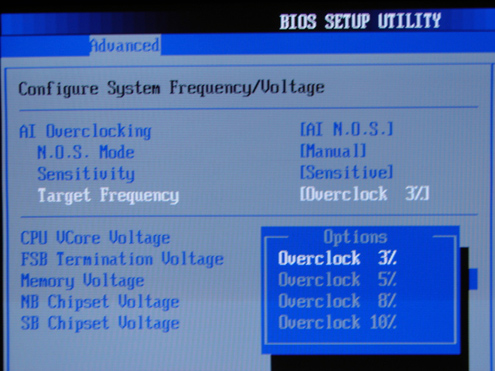Asus P5N32-SLI: Dual x16 - What Dreams Are Made On . . .
by Gary Key on October 27, 2005 12:05 AM EST- Posted in
- Motherboards
Basic Features: Asus P5N32-SLI Deluxe
The Asus P5N32-SLI Deluxe is a member of the ALife product family and, as such, is a fully-featured flagship board targeted towards the PC gamer. The board ships with an extensive accessory package along with several dynamic overclocking features such as AI NOSTM (Non-delay dynamic Overclocking System), AI Overclocking (intelligent CPU frequency tuner with preset profiles), ASUS PEG Link (automatic performance tuning for single/dual graphics cards), ASUS CPU Lock Free (BIOS setting to unlock select multiplier locked CPUs), and the ASUS Ai Booster Utility Precision Tweaker software that allows control over certain system settings within Windows. The board also features the exclusive 8-Phase power design, Copper Heat Pipe technology for cooling the chipsets, Stack Cool 2 design to dissipate heat to the opposite side of the motherboard, and an external SATA II port on the back I/O panel.
| Specification | Asus P5N32-SLI Deluxe |
| CPU Interface | LGA775-based Pentium 4, Pentium XE, Celeron D, and Pentium D processors. |
| Chipset | North bridge- NVIDIA nForce 4 SLI Intel Edition (Crush C19) South bridge- NVIDIA nForce 4 SLI Edition (Athlon CK804) |
| Pentium D Support (Dual-Core) | Full Support |
| Front Side Bus | 1066 / 800 / 533 MHz |
| Front Side Bus Speeds | 533-1600 MHz (in 1 MHz increments) |
| Memory Speeds | Auto- 400-1200 MHz (in 1 MHz increments) |
| System Clock Mode | Optimal, Linked, Expert |
| PCI Express | 100 MHz to 150 MHz in 1 MHz increments |
| Dynamic Overclocking | AI NOSTM (Non-delay Overclocking System) AI Overclocking (intelligent CPU frequency tuner) ASUS PEG Link (Automatically performance tuning for single/dual graphics cards) ASUS CPU Lock Free ASUS Ai Booster Utility Precision Tweaker for Windows |
| Core Voltage | Auto, 1.1V - 1.70V in 0.0125V increments |
| DRAM Voltage | Auto, 1.85 - 2.4V in 0.05V to 0.10V increments |
| Other Voltage | North Bridge - Auto, 1.4V, 1.5V, 1.6V South Bridge - Auto, 1.5V, 1.6V FSB - Auto, 1.215, 1.315, 1.415 |
| LDT (Hyper Transport) Ratios | 200, 400, 600, 800, 1000 |
| Memory Command Rate | Auto, 1T, 2T (current BIOS defaults to 2T) |
| Memory Slots | Four 240-pin DDR2 Slots Dual-Channel Unbuffered Memory to 16GB |
| Expansion Slots | (2) x16 PCIe Slots (1) x4 PCIe Slot (2) x1 PCIe Slots (2) PCI Slots version 2.2 |
| SLI | (2) x16 Fully Supported |
| Onboard SATA | (4)-Drive SATA 2 by nForce 4 |
| Onboard IDE | (2) ATA 133/100/66/33 ports, (4) drive support by nForce 4 |
| SATA/IDE RAID | NVIDIA® nForce4 SLI supports NVRAID - 2 x Ultra DMA 133/100/66/33 - 4 x Serial ATA 3 Gb/s - NVRAID: RAID0, 1, 0+1, 5, and JBOD Silicon Image® 3132 SATA controller supports - 1 x Internal Serial ATA 3 Gb/s hard disk - 1 x External Serial ATA hard disk (SATA On-the-Go) - RAID 0, 1 |
| Onboard USB 2.0/IEEE-1394 | (9) USB 2.0 ports supported by NVIDIA nForce 4 (2) 1394 FireWire ports supported by TI 1394a |
| Onboard LAN | Dual Gigabit Ethernet PCIe Gigabit LAN Support Marvell 88E1111 PHY, Marvell 88E8053 |
| Onboard Audio | Realtek ALC850 8-channel CODEC Universal Audio Jack Audio Sensing and Enumeration Technology Coaxial/Optical S/PDIF out ports on back I/O |
| Power Connectors | ATX 24-pin, 8-pin EATX 12V, 4-pin 12V EZ plug (required for SLI operation) |
| Internal I/O Connectors | 2 x USB connectors supports additional 6 USB 2.0 ports 2 x IEEE1394a connector 1 x COM connector 1 x GAME/MIDI connector CPU Fan / 2x Chassis Fan/ Power Fan / 2x chipset fan connectors Front panel audio connector Chassis Intrusion connector CD / AUX audio in |
| Other Features | Fanless Design AI NET2 network diagnosis CrashFree BIOS 2 Q-Fan2 MyLogo2 EZ Flash |
| BIOS | AMI 0047 |
The Asus P5N32-SLI Deluxe is a member of the ALife product family and, as such, is a fully-featured flagship board targeted towards the PC gamer. The board ships with an extensive accessory package along with several dynamic overclocking features such as AI NOSTM (Non-delay dynamic Overclocking System), AI Overclocking (intelligent CPU frequency tuner with preset profiles), ASUS PEG Link (automatic performance tuning for single/dual graphics cards), ASUS CPU Lock Free (BIOS setting to unlock select multiplier locked CPUs), and the ASUS Ai Booster Utility Precision Tweaker software that allows control over certain system settings within Windows. The board also features the exclusive 8-Phase power design, Copper Heat Pipe technology for cooling the chipsets, Stack Cool 2 design to dissipate heat to the opposite side of the motherboard, and an external SATA II port on the back I/O panel.












70 Comments
View All Comments
Gary Key - Thursday, November 3, 2005 - link
Please email me and I will forward a picture of the remaining inductors without the heatsinks attached. There are eight of them and the picture is high-res so you can make out the various numbers.danidentity - Thursday, October 27, 2005 - link
Does Anandtech plan on reviewing the AMD version of this board? The A8N32-SLI Deluxe?Gary Key - Thursday, October 27, 2005 - link
Yes, Wesley will have it completed shortly.Tanclearas - Monday, October 31, 2005 - link
I look forward to that, particularly compared to the A8N-SLI Premium. I find it highly dubious that x16 SLI shows such noticeable improvements over x8 SLI. I'm not saying it's impossible, but I am definitely skeptical. I would guess there is something else going on between those two boards.Gary Key - Monday, October 31, 2005 - link
Please note that I stated in the article- and -We found anywhere from a 3% to almost 11% difference between the x8SLi and x16SLI configurations with the first 3% coming from differences between the two respective board suppliers and the additional 7~8% coming from the additional bandwidth/optimizations at the higher resolutions between the two boards. The driver set utilized (81.85), video cards (7800GTX), applications (GPU intensive F.E.A.R.), driver settings (AA/AF on), and cpu combination account for the difference. We will have additional information on this in future articles including different game benchmarks were the differences are not as great but the base improvement still exists. There is a true base difference between the two configurations (could vary by board design) with the 81.85 driver set accounting for the majority of the difference after this initial improvement.
Tanclearas - Monday, October 31, 2005 - link
No need to get defensive. I just think that a single comparison of two boards (from two different manufacturers) does not make a conclusive argument for those improvements being from x16 vs x8 SLI configurations. If the tests show the same pattern for the A8N-SLI Premium and A8N32-SLI, then I will start to believe that the additional PCIe bandwidth is indeed what is behind the increases. Right now, we have a sample of one, which should never be the basis of a conclusion.Gary Key - Monday, October 31, 2005 - link
I am not getting defensive and did not mean for the message to come across that way. I had clearly stated that several factors played into the equation and I agree the additional bandwidth is only part of the equation. However, the same base advantage held true over the MSI P4N with the Gigabyte Quad board with the 78.01 drivers and in SLI operations with the 81.84 and 81.85 beta drivers. I agree about testing x8sli against x16sli from the same manufacturer but in this case the x8sli board would have been the P5ND2-SLI Deluxe which had severe issues in several areas. In this example the argument would have made that testing any another x8sli board would have been more beneficial for results. ;->breetai72 - Monday, October 31, 2005 - link
Are the benchmarks used for comparison from old reviews or did you rerun the tests again for this review? If so, the results aren't worth comparing to given what you said about difference in drivers, etc.I find it very hard to believe that any graphics setup is exceeding the bandwidth of a x8 slot. The private pixel bus handles most of the traffic anyway.
Gary Key - Monday, October 31, 2005 - link
I reran all of the benchmarks for this article and also standardized on DDR2-667 at 3-2-2-8-1T as stated on the Test Setup page. There was no difference in numbers between the beta 81.85 and whql 81.85 drivers we used for the article. The 7800GTX SLI setup has the ability to exceed the x8 slot capacity and this is shown in the base benchmarks. I am sure the next article to be published will further show the differences between x8sli and x16sli. ;-) However, I will state once again that the main increases will come from the 81.85 drivers, certain GPU intensive games, 7800GTX SLI setup, additional AA/AF settings, and higher resolutions.Gary Key - Monday, October 31, 2005 - link
Should be- "different game benchmarks where the differences". I hit the enter button accidently before checking my spelling.